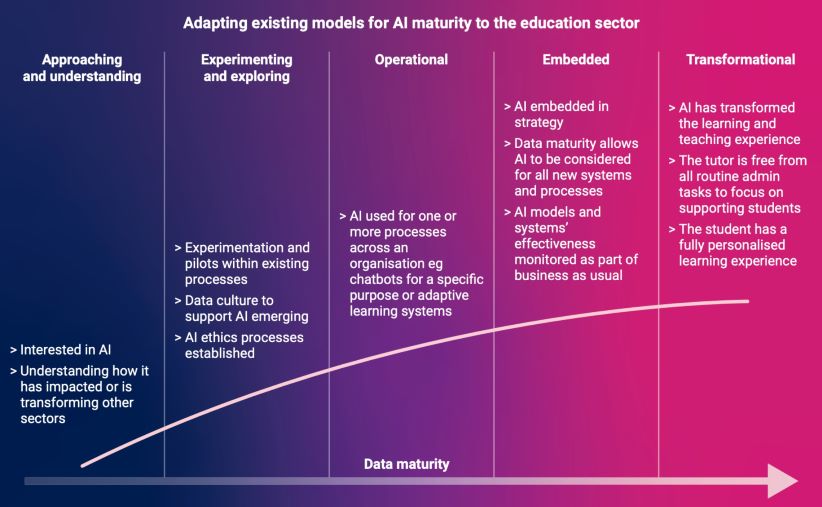In this installment of the AI in Education: Here and Now series Rob Howe, Head of Learning Technology at University of Northampton, shares his experiences of conducting pioneering AI Pilots.
The University of Northampton has been following A.I. developments for many years and discussion on this topic is now integrated into some of the academic programmes. Vendors are now increasingly using A.I. as part of their products – particularly when trying to make sense of big data. Some are mentioning A.I. as part of sales promotions although the real functionality is sometime more hidden.
Enthusiastic staff and students within the University have been reviewing and working with A.I. within their specific areas but much of this activity had not been aggregated. Whilst there was no current desire to control the level of activity, opportunities were being missed to join relevant individuals together to share expertise. This also meant that approaches from vendors could not effectively be directed within the institution – leading to possible missed opportunities or duplication of effort.
In 2021, the author developed a scoping document as part of a presentation to the University Management Team to raise awareness about current activity around A.I. The document provided some background around the subject area and then sought to categorise functional areas within the institution.
The first challenge was to unpick some of the common terminology used in in this area. The article from A.I. trends was found to be useful and unpick some of the misconceptions in terminology.
Artificial Intelligence (AI) – This is where computer systems are developed to perform tasks that would typically demand human intervention.
Machine learning is a branch of artificial intelligence where a class of data-driven rules enables software to become accurate in predicting outcomes without any need for explicit programming.
“Deep Learning” or “Neural Network” machines is a development from older ML approaches in performance and are currently considered state-of-the-art in performance in fields ranging from computer vision and natural language understanding to playing complex games.
Data science can be described as the description, prediction, and causal inference from both structured and unstructured data. This discipline helps individuals and enterprises make better business decisions.
The relationship between these is represented by the following diagram:

From AI Trends – https://www.aitrends.com/data-science/machine-learning-engineer-vs-data-scientist-who-does-what/
As part of developing the scoping document, the author referenced the work emerging from the new Jisc AI Team. This was led by Jisc and supported by innovation-focused universities and colleges throughout the UK. The national centre produced a summary of the state of AI in tertiary education and also a schematic on the various stages of data maturity towards the use of AI:

The key dimensions identified in this schematic with evolving data maturity proved useful when applied to the different functional areas within the University. The evolving grid provided the institution with areas where there was already activity and also where there were new opportunities which had not been exploited. This information could then be used to develop a requirement specification to target potential suppliers. Small-scale pilots would be needed to better understand the potential which was available and further inform our requirements.
Three key A.I. pilots were identified:
- The use of Chatbots to aid the early socialisation of students.
- Investigation of partially automated formative setting and grading tools.
- Tools to assist with improved service desk efficiency.
All three of the pilots are – at the time of writing – in the process of user activity and the results are being used to inform future developments and requirement specifications.
The work on partially automated formative setting and grading tools (2) was initiated following an initial demonstration from the company Noodle Factory The product showed potentially interesting applications for formative student assessment. It also appeared to show potential benefits to impact positively on student workload. Following approval of a Data Protection Impact Analysis (DPIA) and IT Security review, two members of academic staff covering both undergraduate and postgraduate studies volunteered to pilot the product. Several support meetings were held between the company and the University to upskill us in the use of the tool and also begin preparation of material. An initial pilot was then conducted with a small group of students in respective areas to obtain their feedback. This has enabled us to refine the requirement specification.
The University has now formalised research into A.I. with the advent of a dedicated special interest group (SIG) under the guidance of the Centre for Active Digital Education (CADE). The Centre will help focus activity both within and outside the institution, seek funding to assist future pilots and conduct research in the applications of systems and tools.
Some thoughts for those planning to undertake pilots:
- Engage with the Jisc AI Team to review work already in progress and then build on these activities.
- Use the AI maturity model to conduct a scoping exercise within your own institution
- Consult widely within the institution as there may be activity happening in silos.
- Conduct small scale pilots to further enhance understanding and capability around A.I. functionality
- Use the outputs of steps 1-4 to develop a requirement specification.
- Do not let enthusiasm for AI overshadow the true requirements – you may find that a process review is all that is needed rather than a new piece of software.
- Keep reviewing the sector
- Be open to the potential for future AI developments within your institution – integrate these within a Centre or responsible team.
- Not all pilots will be successful – you may need to backtrack and try a different path
- Recognise the time and effort from staff involved in the pilots – they may feel demoralised and wish to disengage with future pilots if not fully briefed with the process.
Rob Howe, Head of Learning Technology, University of Northampton
If you would like to get in touch with Rob and find out more about his work, he can be reached as follows:
- Twitter: @rjhowe
- LinkedIn: https://www.linkedin.com/in/rob-howe-b26a145/
- Email: Rob.Howe@northampton.ac.uk
Find out more by visiting our Artificial Intelligence page to view publications and resources, join us for events and discover what AI has to offer through our range of interactive online demos.
For regular updates from the team sign up to our mailing list.
Get in touch with the team directly at AI@jisc.ac.uk
